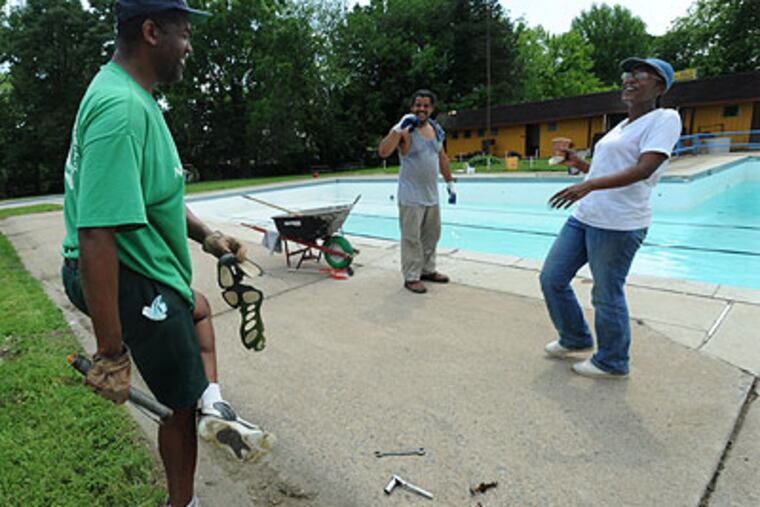Working to save the historic Nile Swim Club in Yeadon
The weight of a crippling tax bill is threatening to drown the historic Nile Swim Club of Yeadon. But neighbors of the 52-year-old club refuse to think about anything but a happy ending to the story.

The weight of a crippling tax bill is threatening to drown the historic Nile Swim Club of Yeadon.
But neighbors of the 52-year-old club refuse to think about anything but a happy ending to the story.
So, a few days ago, a neighborhood contractor, a youth leader, and a landscaper were part of a group that spruced up the 4.5-acre facility to make sure it opens on Saturday for the holiday start to the summer season.
"It means a whole lot to the community," said Michael Graham, owner of a landscaping business, who was trimming grass around the pool. Graham grew up in the house next door to the Nile. "It'll be a shame if it doesn't make it," he said.
Club officials filed for bankruptcy protection in September to stave off a threatened tax sale of the nation's first private swim club owned and operated by African Americans.
The Nile is facing a struggling economy, a weighty tax burden, and increased competition that has forced nearby swim clubs out of business or into the hands of municipalities that purchased the properties.
"In order for us to survive, we have to update [the facility], there is no getting around it, said Kathy Jordan, president of the club. "But it depends on the money."
Officials have started a fund-raising drive that they hope will stabilize finances and ultimately fund new construction. A new indoor pool, banquet hall, and renovated outdoor pool are necessary for the Nile to compete with other facilities and generate revenue year around.
But the challenge to survive is daunting. The Nile owes a $90,049 in delinquent taxes through 2009, according to public records. In addition, the club's $36,768 tax bill for 2010 is unpaid, tax records say.
The club's tax bill shot up unexpectedly when a parcel of the club's land was reassessed, said Darrell Henderson, former president. The club is awaiting a hearing that will determine a payment schedule, Henderson said.
Also, club revenue has steadily declined. Family memberships have decreased to about 125. Memberships typically cost a one-time fee of $500 (with annual dues starting at $125).
The Nile's site has changed little since its heyday in the 1960s and 1970s when its pool parties were a hot ticket and celebrities such as Harry Belafonte stopped by. The club opened in 1959 as a place for African American kids to enjoy swimming at a time when municipal pools were unwelcoming. (Today, members are primarily African American, but they are also white, Latino, and Asian.)
The club has its original L-shaped pool. There is also a kiddie pool, a clubhouse, pavilion, and snack bar.
"The old-fashioned swim club" has lost some of its appeal," said Jeff Wiltse, author of Contested Waters: A Social History of Swimming Pools in America.
They face competition from newer facilities that have water-park-like interactive activities in the pool, Wiltse said. Also, families have a wider range of leisure-time activities to choose from, making swimming just one of many.
In Yeadon, borough officials are planning to build a state-of-the art tennis and recreation center on the site of the old Yeadon Swim Club, which could also compete for the recreation dollars of area families.
The Nile needs an extensive examination of its market demographics and club goals to not only drive its fund-raising, but ultimately to create the kind of swim club that will be successful, said award-winning swim coach Jim Ellis, senior aquatics director at the new Salvation Army Kroc Center of Philadelphia, and subject of the movie Pride.
"Who do you want to be? Who do you want to serve? Where is your membership coming from? Is the community changing? These are all questions you need to ask," said Ellis, who was heavily involved in the fund-raising for the Kroc Center.
Swim coach and historian Lee Pitts asks programming questions. "Do you have infant and toddler swimming? Can my kids get into competitive swimming? Do you have water aerobics?" said Pitts, producer of an instructional DVD and author of "Black Splash: The History of African-American Swimmers," an article for the International Swimming Hall of Fame. "Why should I choose you?"
For Nile officials, there is only one answer to the question they care most about. Will the Nile survive? They say, absolutely. A new Friends of the Nile group has been created to develop contributors. A membership drive that includes going door-to-door and offering reduced membership fees is under way. Two fund-raising events have been held and another, Sisters at the Nile, is scheduled for June 24. The club also has a new grant writer.
At the pool on Thursday, heavy-equipment operator Clifford Brock squatted in the hot sun to replace the wood in benches surrounding the pool. Graham's landscaping team cut the grass. The Cooper family - Shenell and Peter and their children Saadia and Jewlyin - painted walls and patched up.
"A small group of families concerned about kids founded this place," Peter Cooper said. "It's important to be part of it. Hopefully it will be here for another hundred years."